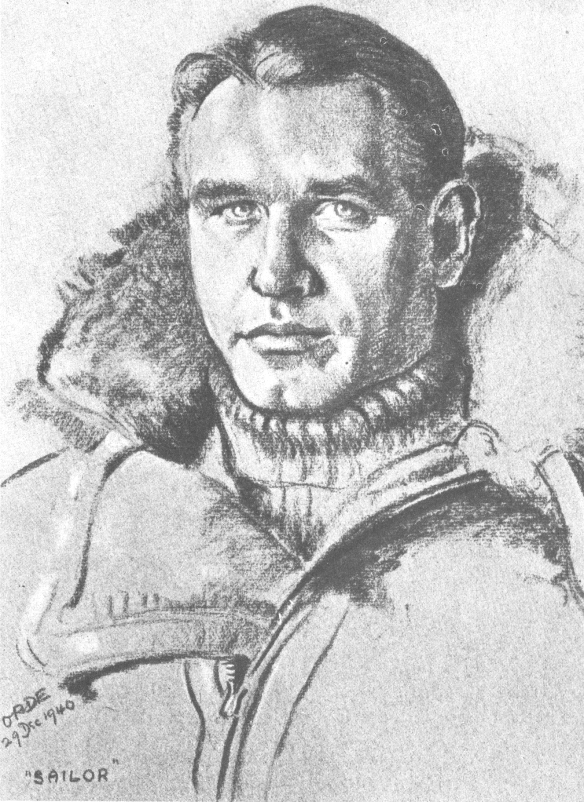
‘Sailor’ Malan, so nicknamed because he had served in the merchant navy before becoming a pilot. Sailor Malan by Cuthbert Orde, 1940
Air Chief Marshal Sir Hugh Dowding and an aide pictured alongside several of “The Few” outside the Air Ministry on 14 September 1942. From left to right are: Squadron Leader A.C. Bartley DFC; Wing Commander D.F.B. Sheen DFC; Wing Commander I.R. Gleed DSO DFC; Wing Commander Max Aitken DSO DFC; Wing Commander A.G. Malan DSO DFC; Squadron Leader A.C. Deere DFC; Air Chief Marshal Sir Hugh Dowding; Flight Officer E.C. Henderson MM; Flight Lieutenant R.H. Hilary; Wing Commander J.A. Kent DFC AFC; Wing Commander C.B.F. Kingcome; Squadron Leader D.H. Watkins DFC; and Warrant Officer R.H. Gretton. (HMP)
Sunday 28 July saw two of the greatest pilots of the Battle duel for the first time, during a day which cost Fighter Command four aircraft, and the Luftwaffe eight aircraft, including four Bf 109Es. Another Bf 109E was badly damaged when its engine failed after being hit in the same combat. For a change, that Sunday dawned bright and clear, and Fighter Command moved eight squadrons forward to advanced landing grounds. To counter a large raid approaching Dover, Fighter Command scrambled the Spitfires of No.74 Squadron (led by ‘Sailor’ Malan) from Manston, and a squadron of Hurricanes from Hawkinge. The Hurricanes were under orders to attack the enemy bombers, leaving the Bf 109Es to No.74. The enemy bombers turned back without dropping their bombs, and Malan found himself leading his dozen Spitfires against more than 40 Bf 109Es from I./ and II./JG 51, led by Major Werner Molders. Malan downed one of the 109s in the leading Kette, and then raked another from spinner to rudder post. This aircraft dropped out of the fight and limped back to Wissant, where it crash-landed. Its pilot, Molders himself, was lightly wounded, and had to leave the unit to recuperate. No.74 Squadron downed three of the Bf 109Es, and seriously damaged three more, for the loss of two of its own Spitfires.
#
Although the RAF certainly matched the Luftwaffe during July, its success carried with it a heavy price. 80 regular RAF Squadron and Flight Commanders had been killed or wounded, and most tactical formations were now being led by officers whose experience of handling formations was brief, and limited. Even pre-war officers like ‘Sailor’ Malan who were newly qualified as Flight Leaders (Malan just before the war), would soon be Squadron or even Wing Leaders. Men and machines were relatively easy to replace – by the end of July, Dowding was able to establish his squadrons at 20 aircraft each (plus two ‘Command Reserves’) and the Command’s pilot strength was 214 higher on’ 31 July than it had been on the first day of the month. Dowding increased the established number of pilots (generating an immediate on-paper shortage), but the actual number of pilots never dropped as low as it had been as the Battle started. But experience could not be replaced, and the best of the new boys inevitably needed time and training before they could handle their aircraft (let alone an entire formation) with the ease that the pre-war, peacetime-trained pilots took for granted.
#
NO.74 Squadron spent the early part of the war shuttling between Hornchurch and its satellite base at Rochford, gaining some Spitfire IIAs in June 1940, and beginning the Battle of Britain at Hornchurch. The squadron moved to Wittering for one week from 14 August, then to Kirton on Lindsey, and, on 9 September, to Coltishall. It returned to NO.11 Group on 15 October, taking station at Biggin Hill. NO.74’s most famous pilot was Adolf Malan, a South African former merchant seaman who became a Flight Commander on NO.74 in 1938. Malan officially scored only six confirmed kills during the Battle (adding to eight confirmed kills before it), but was credited with four more enemy aircraft damaged, plus one unconfirmed and two probables. After the Battle his score eventually reached 32 kills – making him the RAF’s topscorer until overtaken by Johnnie Johnson. It was also his practise to ‘give’ kills to young wingmen to encourage them and increase their confidence, making it likely that his real score was significantly higher. Malan took command of NO.74 from F.L. White in August 1940. NO.74 Squadron pilots were extremely punctilious in their claims, and most pilots had a higher proportion of probable and damaged claims than on other units. The squadron’s tally between June and November of 86 kills should be viewed in this light, as does its relatively modest ranking at NO.8 in the list of Battle of Britain fighter units. Its aircraft wore ‘ZP-‘ codes.